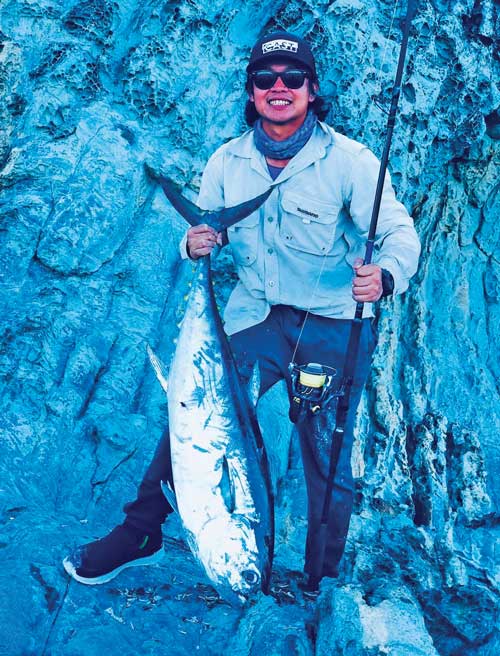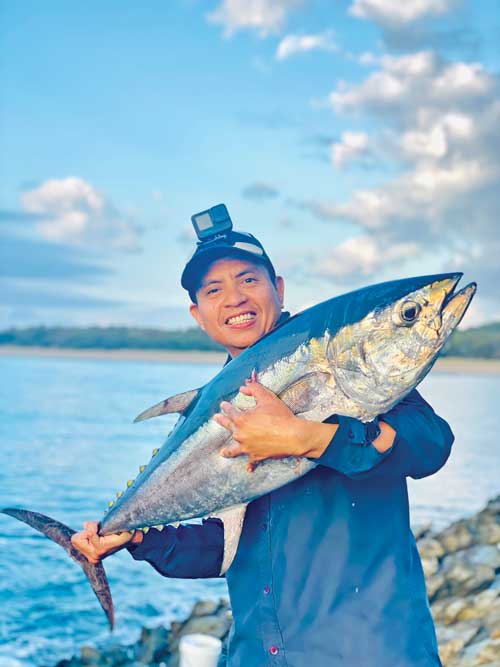Hopefully, by the time this hits the stands, we should be having some better weather periods. winter
It hasn’t been playing the game lately, with only small windows of opportunity to head out inshore or offshore.
We are certainly starting to see the weather shift to more of a typical winter pattern, which means we’ll get wind in the morning and glassy afternoons.
During the warmer months, there is no wind in the morning and a northeasterly change kicks in after lunch.
So, in winter, instead of heading out early, most seasoned anglers will go after lunch for an overnighter.

They use the afternoon to travel to their spot, fish there most of the night and half the next day, then come home when the wind drops out again.
During these small weather windows, there have been some very cool captures.
A few of the boats that headed north of Yeppoon did well on big inshore grunter and small-mouth nannygai.
Generally speaking, when both of these species get caught together, they are inhabiting many of the inshore wrecks.
One of the disadvantages of fishing inshore wrecks is that when you do get a good bite going, the men in grey suits rock up and ruin the party.

In the past, it was the warmer months that they made pests of themselves, yet it seems it’s all year round now.
If the sharks show up, all you can do is move on.
If you can get the timing right on those wrecks though, they can fish very well.
Spots that are well known and regularly fished still produce amazing results at times.
Fishing them at night can be a real lucky dip, plus we have less issues with sharks for some reason.

I remember being on a hot grunter bite one night on a wreck about 40km north of the marina and, in the middle of that bite, we boated a 10kg large-mouth nannygai, which topped off a solid session.
Back on the headlands, the fishing was fairly good once the water cleared.
I know a few locals who float live bait and spin for mackerel have been tangling with some massive tuna recently.
When the fish are on, it can be shoulder to shoulder on those popular headlands – the next 20kg spanish mackerel that gets caught there won’t be the last.
One species that always turns up wide when the water temperature drops is snapper.
And they aren’t limited to only wide grounds either.

We have caught them on inshore rubble patches, around the islands and all the way out to 100km offshore.
In our experience, snapper like a good fresh bait best.
Fresh strip bait or squid are a safe bet.
If you want to run live bait for them, you can’t go passed a nice live yakka.
Yakka tend to work best when nothing else seems to be getting any interest.
When the going gets tough, make sure you downsize everything.

Sometimes we’ll run a 40lb fluorocarbon leader and use 5/0 hooks to get a bite.
Finesse can be the difference between catching a feed or buying fish and chips when you get home.
Moving into the estuaries, blue salmon are now in full swing.
Plenty of schools are in most of the estuaries throughout the net-free fishing zone.
I would rate Corio Bay as one of the easiest places to catch a feed of blue salmon.
When the blueys start to get caught off the beaches and rock points, you know they are thick everywhere.

Occasionally, it doesn’t matter what you cast at them, when blueys are boiling, they will eat anything.
I know of a few anglers who have caught them on squid jigs even, just to prove a point.
With small neap tides during winter, it’s a prime time to chase fish on the flats.
Good weather periods and small tides will get that water nice and clear, so you can see those fish cruising on the flats.
Most fishos prefer to chase flats fish on fly gear.
A flats fly angler in full swing is a sight to see.
There’s a proper art to it – though its not a technique I’ve had a go at yet.

Plenty of species are on offer for this kind of fishing, including trevally, queenfish, bonefish, tarpon, tuskfish and blubberlip.
It’s a very exciting form of fishing, yet you do need to apply as much stealth as possible.
Noise travels a long way under water and fish in shallow water are extra flighty already.
Moving slowly and casting a long distance will give you better opportunities.
Well, that’s it from me. winter
Make sure to get those kids out on the water at every opportunity.
Stay safe and I’ll catch you next month.
 Bush ‘n Beach Fishing Magazine Location reports & tips for fishing, boating, camping, kayaking, 4WDing in Queensland and Northern NSW
Bush ‘n Beach Fishing Magazine Location reports & tips for fishing, boating, camping, kayaking, 4WDing in Queensland and Northern NSW









